Many WDAS Members will have heard Sean Paling’s talk about hunting for Dark Matter in Boulby Mine, and followed updates of how successive experiments are progressing. So let’s take another look at Dark Matter: why we think it’s there and what it is.
Why Dark Matter?
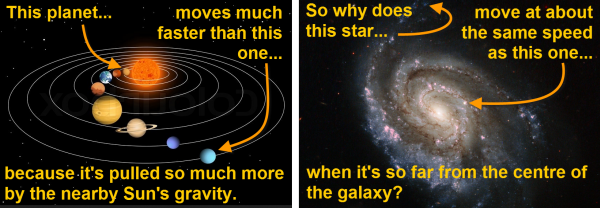
In our own solar system Mercury is moving faster than Earth, and Earth faster than Neptune. That’s because their speed is a measure of the Sun’s gravitational pull, which is stronger the closer you are to it. Hallelujah… the laws of physics are working!
But wait, the stars at the edge of a galaxy rotate around the super-massive blackhole at its heart, at more-or-less the same speed as stars much closer in. That should be impossible! In fact, galaxies are rotating so fast that – by rights – they should be flying apart. Unless… there’s a whole lot more mass spread around the galaxy that we can’t see. What would be a good name for it..?
And since that discovery, the evidence for Dark Matter has just been piling-up. Everything, from the evolution of the entire universe to the leftover signals from the Big Bang, seems to scream, “DARK MATTER.” Astronomers are now able to model the Universe and put a figure on how much of it there is… about 84% of actual matter in the Universe is Dark Matter. And since it responds to gravity, we can also map its location and its speed, and we find it’s actually shaped the Universe. Yes, Dark Matter is responsible for the large-scale filament structure of our Universe.

So what’s it actually made of? Well, there have been various ideas:
1. MOND (Modified Newtonian Dynamics)
 At first it was thought that maybe gravity didn’t work the way Einstein told us, and there are some cosmologists who have tried to tweak the laws of gravity to fit our observations. The trouble is, successive discoveries keep shooting holes in their maths! Most cosmologists accept that Dark Matter is out there and want to understand what it is.
At first it was thought that maybe gravity didn’t work the way Einstein told us, and there are some cosmologists who have tried to tweak the laws of gravity to fit our observations. The trouble is, successive discoveries keep shooting holes in their maths! Most cosmologists accept that Dark Matter is out there and want to understand what it is.
Some ideas come from “old physics” (the stuff we already know about) and others from “new physics” (exotic stuff we haven’t discovered yet).
2. Old Physics: Regular Matter
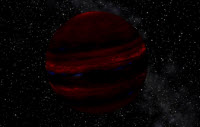 There’s lots of stuff in the universe that doesn’t glow, and it’s really tough for us to see. Black holes (of course), but also neutron stars or brown dwarfs: based on a survey of our very local galactic neighbourhood they are far more numerous than ‘real’ stars. Together all these dark objects are called MACHOs: Massive Compact Halo Objects. (Halo?? Well, you know how it is!) The problem is, we can’t scale-up our local observations to anywhere close to the amount of “missing matter”.
There’s lots of stuff in the universe that doesn’t glow, and it’s really tough for us to see. Black holes (of course), but also neutron stars or brown dwarfs: based on a survey of our very local galactic neighbourhood they are far more numerous than ‘real’ stars. Together all these dark objects are called MACHOs: Massive Compact Halo Objects. (Halo?? Well, you know how it is!) The problem is, we can’t scale-up our local observations to anywhere close to the amount of “missing matter”.
3. Old Physics: Neutrinos
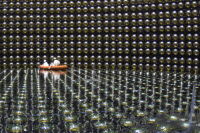 Here’s an attractive idea: neutrinos have hardly any mass at all, they don’t emit light, they’re devilishly difficult to detect, and absolute squillions of them were made in the Big Bang, not to mention inside stars (and even a few made inside of you!) The problem is, neutrinos move wayyy to fast to clump together the way we’ve seen dark matter clumped together in huge structures like galaxies.
Here’s an attractive idea: neutrinos have hardly any mass at all, they don’t emit light, they’re devilishly difficult to detect, and absolute squillions of them were made in the Big Bang, not to mention inside stars (and even a few made inside of you!) The problem is, neutrinos move wayyy to fast to clump together the way we’ve seen dark matter clumped together in huge structures like galaxies.
4. New Physics: WIMPs (Weakly Interacting Massive Particles)
 These are the things Sean’s team is looking for in Boulby Mine (along with various other teams across the world). Apart from being, by definition, hard to detect, another problem that the form of WIMPS isn’t well defined. For example, we’ve little certainty about their likely size. For this reason, it’s taken a long time to search through all the different possible types of WIMP, and by now the bigger problem is that we’re getting close to ruling out all likely forms of WIMP without finding a trace. So, as I asked Sean at Astromeet, “if not WIMPs, then what?”
These are the things Sean’s team is looking for in Boulby Mine (along with various other teams across the world). Apart from being, by definition, hard to detect, another problem that the form of WIMPS isn’t well defined. For example, we’ve little certainty about their likely size. For this reason, it’s taken a long time to search through all the different possible types of WIMP, and by now the bigger problem is that we’re getting close to ruling out all likely forms of WIMP without finding a trace. So, as I asked Sean at Astromeet, “if not WIMPs, then what?”
5. New Physics: New Neutrinos
 Some cosmologists think there might be a new kind of super-heavy neutrino that we just haven’t detected yet, because you wouldn’t need as many heavy neutrinos to account for dark matter as you would light neutrinos. So far, however, none of have been spotted.
Some cosmologists think there might be a new kind of super-heavy neutrino that we just haven’t detected yet, because you wouldn’t need as many heavy neutrinos to account for dark matter as you would light neutrinos. So far, however, none of have been spotted.
6. New Physics: Axions (from the Greek ἀξίωμα – “that which is thought”)
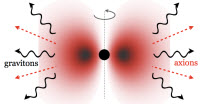 Axions are about as exotic as it gets: hypothetical particles, postulated to resolve a problem in a branch of quantum physics. If they exist, and if their mass is within a particular range, they could be responsible for Dark Matter. But that’s a couple of big Ifs.
Axions are about as exotic as it gets: hypothetical particles, postulated to resolve a problem in a branch of quantum physics. If they exist, and if their mass is within a particular range, they could be responsible for Dark Matter. But that’s a couple of big Ifs.
7. New Physics: Supersymmetry
 The idea that every particle in the Universe has a kind of heavy twin, and that one of those twins would be dark matter. The famous Large Hadron Collider (LHC) at CERN in Geneva looked hard for them, but failed to spot them within its original power range. After major upgrades, it was turned on again at the end of April 2017 and the search continues. (I’ve detected more doubt than optimism among scientists that they’re going to find their quarry.)
The idea that every particle in the Universe has a kind of heavy twin, and that one of those twins would be dark matter. The famous Large Hadron Collider (LHC) at CERN in Geneva looked hard for them, but failed to spot them within its original power range. After major upgrades, it was turned on again at the end of April 2017 and the search continues. (I’ve detected more doubt than optimism among scientists that they’re going to find their quarry.)
8. New Physics: Parallel Universes
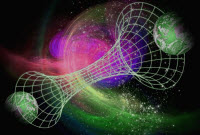 Yes, there are even some researchers who think we’re seeing the effects of parallel universes messing with ours. But, again, there is no direct evidence for any of these new ideas.
Yes, there are even some researchers who think we’re seeing the effects of parallel universes messing with ours. But, again, there is no direct evidence for any of these new ideas.
So, where does that leave us:
- No-one has seen a super-heavy neutrino
- No-one has seen an axion
- No-one’s supersymmetric twin
- No-one has seen a parallel universe
- Most forms of WIMPs also ruled-out
- Experiments have ruled out the simplest models of heavy neutrinos and supersymmetry
- Axions have been ruled-out as an explanation for at least the majority of dark matter out there
- Not enough MACHOs (by far) to account for the mass and regular Neutrinos are far too fast.
So for now, we’re stuck.
Cosmologists around the world are working as hard as they can to understand dark matter better, from the ones staying up all night at the telescope to the ones staying up all night at the blackboard. But as it stands right now, the vast majority of the matter in the universe remains a complete mystery.
The video and inspiration for this article was brought to you by YouTube channel "SciShow Space". You can support their work creating videos that help to teach the world about astronomy by sponsoring a dollar or two per month via their Patreon page.
- Log in to post comments


